The lateral appendages growing exogenously from the nodes of the stem are called leaves, Leaves may also grow on the branches. In few plants the stem is reduced and the leaves appear as if they are on the top of the root system. The leaves are usually flat and green. They have limited growth and are arranged acropetally. Axillary buds develop in the axil of the leaf.
Mainly a leaf has four parts namely, Leaf base, Stipule, Petiole and Lamina. Let us study each of them.
Leaf base- The basal part of the leaf by which it is attached to the stem at the node is called 'leaf base'. Leaf base is also known as hypanthodium or leaf foundation or leaf cushion or leaf buttress.
Stipule- The small, green lateral appendages present on either side of the leaf base are called 'stipules'. They protect the axillary buds in developing stages. They are prominent in dicots and rarely appear in monocots.
The stipules may be deciduous if they fall off by the time lamina expands (Eg : Michelia) or persistent (Eg: Lathyrus, Pisum) if they remain as long as the leaf remains. When the leaf has stipules it is called stipulate and if stipules are absent then the leaves are called 'exstipulate'. It is interesting to know that the stipules are branched in Ipomea quamoclit.
The following are ten main types of stipule present in a plant.
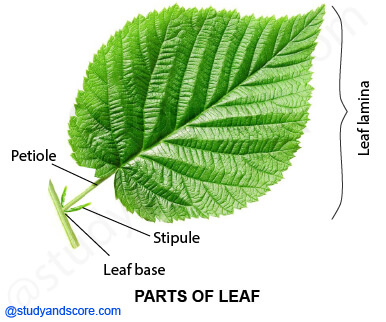
Petiole- The stalk like structure which connects the lamina to the stem is called petiole. The petiole exposes the lamina to light. Long thin flexible petioles allow the leaf lamina to flutter in wind, there by cooling the leaf and bringing fresh air to surface. It bears the weight of the lamina and conducts water and food materials between the stem and leaf. The leaf may be petiolate (with petiole) or sessile (without petiole).
Lamina- The green expanded part of the leaf is called 'lamina' or the leaf blade All the important functions of the leaf are performed in this part only.
The arrangement of veins and the veinlets in the lamina of the leaf is termed as venation. The vascular bundles entering from the stem into the leaf divide and redivide to form many branches called veins. The main vein present at the centre of the lamina is called 'midvein' or 'midrib'. This forms branches called 'lateral veinlets'. Veins not only provide definite shape and strength to the leaf lamina but also expand it to get sufficient amount of sunlight. The veins help in transportation of water, minerals and food materials.
Types of venation
In angiosperms venation is of two types namely Reticulate venation and Parallel venation.
Reticulate venation: This type of venation is commonly found in dicots and rarely in some monocots like Smilax, Alocasia and Dioscorea. In this, the midvein produces many lateral veins. Lateral veins divide and redi videforming a network of veinlets in the lamina. Depending on the number of midveins the reticulate venation is of two types namely Pinnately reticulate venation and Palmately reticulate venation.
a) Pinnately reticulate venation
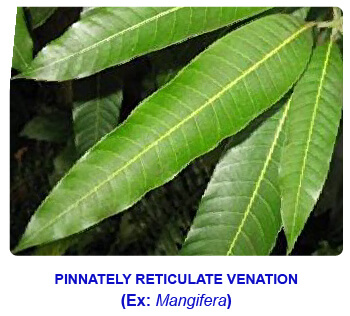
b) Palmately reticulate venation
Convergent- In this the midribs run through the unlobed leaf lamina and unite at its apex. Example: Ziziphus
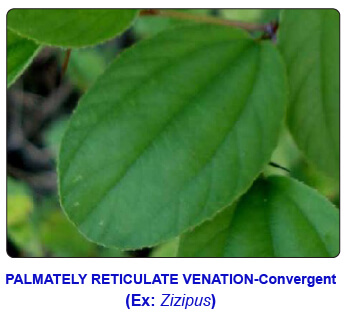
Divergent- In this, the midribs enter into each lobe separately in a palmately lobed leaf lamina. Eg: Passiflora, Gossypium, Cucurbita.
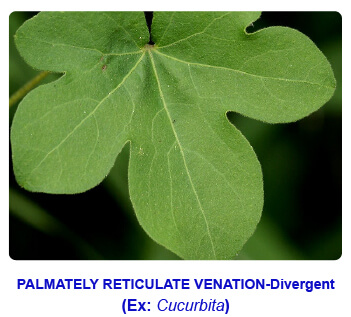
***Dicotomous venation is seen in Ginkgo biloba and in Pteris open dichotomous venation is seen.
Parallel venation- When the veins run parallel to each other within a lamina, the venation is termed as parallel venation. It is commonly found in monocots and rarely in some dicots like Caulophyllum and Eryngium. It is of two types:
a) Pinnately parallel venation
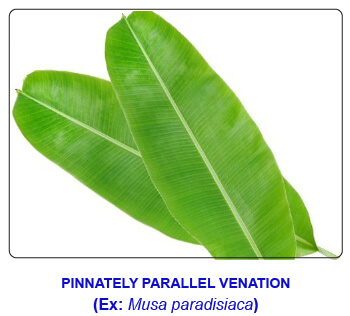
b) Palmately parallel venation
Convergent- In this, the midveins arise from the basal part run parallel to each other and unite at the apex in an unlobed leaf lamina. Example: Oryza sativa
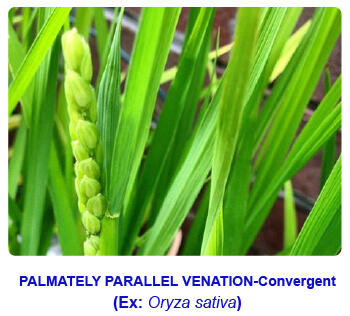
Divergent- In this, the mid veins arise from the basal part and enter into each lobe in a palmately lobed leaf lamina. Example: Borassus.
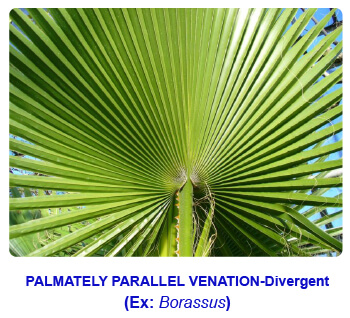
* Caducous leaves are the leaves which fall down in early stage of development. Caducus is a Latin word which means "to fall". Caducous leaves are found in Opuntia.
Based on the morphology (like external form and structure of the leaf balde) the leaves are broadly classified into two types namely Simple leaves and compound leaves.
Simple leaves: In this, the petiole bears one lamina at its apex. The lamina is either lobed or unlobed. Example: Annona and Psidium.
Simple leaf with pinnately lobed lamina is found in Brassica.
Simple leaf with palmately lobed lamina is found in Ricinus, Passiflora, Cucurbita, Carica, Gossypium
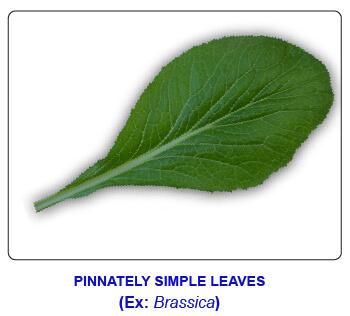
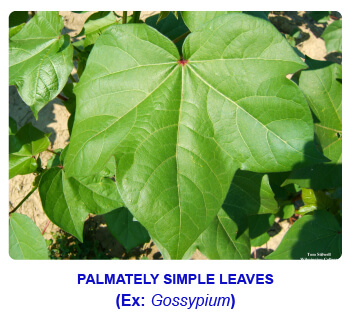
Compound leaves: The lamina is dissected upto midrib or upto tip of the petiole to form many leaflets. Compound leaves contains axillary buds. The leaflets do not contain axillary buds. The axis of the compound leaf is called 'rachis'. A bud is present in the axil of petiole in both simple and compoun leaves, but not in the axil of leaflets of the compound leaf.
The compound leaves may be of two types namely Pinnately compound and Palmately compound leaves. Let us study each of them:
Pinnately compound leaves: : In a pinnately compound leaf, a number of leaflets are present on either side of a common axis the rachis. Based on the number of branches on the rachis the compound leaves are of four types.
1. Unipinnately compound leaf: In this type the rachis is unbranched and the leaflets are arranged directly on it. Depending upon the number of leaflets, it is of two types,
(i) Paripinnate: In this type, the leaflets on the rachis are even-numbered and the rachis terminates into a pair of leaflets. Example: Tamarindus, Cassia
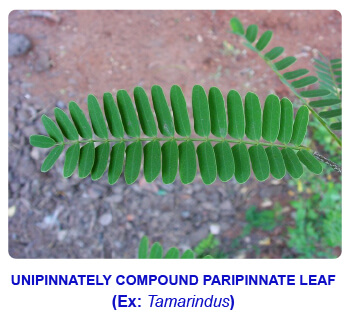
(ii) Imparipinnate: In this type, the rachis ends with a single leaflet and thus the leaflets are in odd numbers. Example: Rosa, Azadirachta
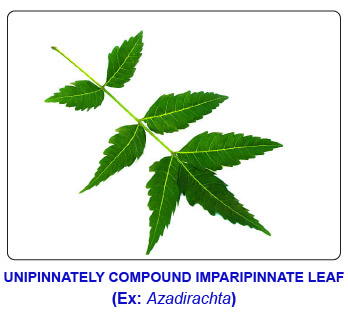
2. Bipinnately Compound leaf: In this type, the leaflets are developed on the secondary rachii the branches formed the primary rachis. Example: Acacia arabica, Delonix regia.
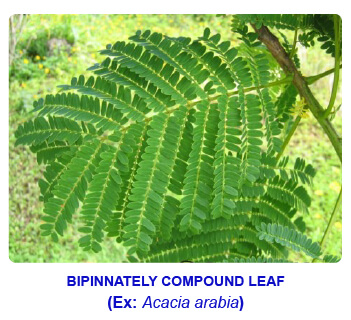
3. Tripinnately compound leaf: In this type, the primary rachis produces secondary rachii, ^vhich in turn give rise to tertiary rachii. The leaflets are developed on tertiary rachii. Example: Moringa, Millingtonia
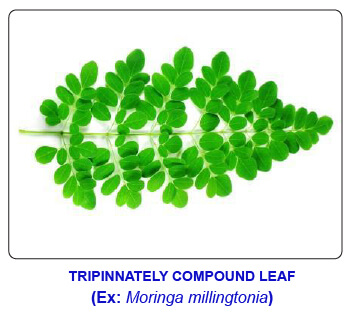
4. Decompound leaf: In this type, the rachis divides irregularly and repeatedly and the leaflets are developed on the terminal rachii. Example: Coriandrum.
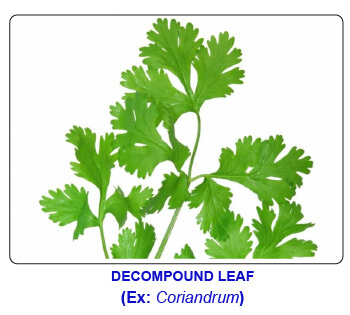
Palmately compound leaves: In palmately compound leaves, the leaflets are attached at a common point which is the tip of petiole. Rachis is not found in this type of leaf. Depending upon the number of leaflets the palmately compound leaf is divided into following types:
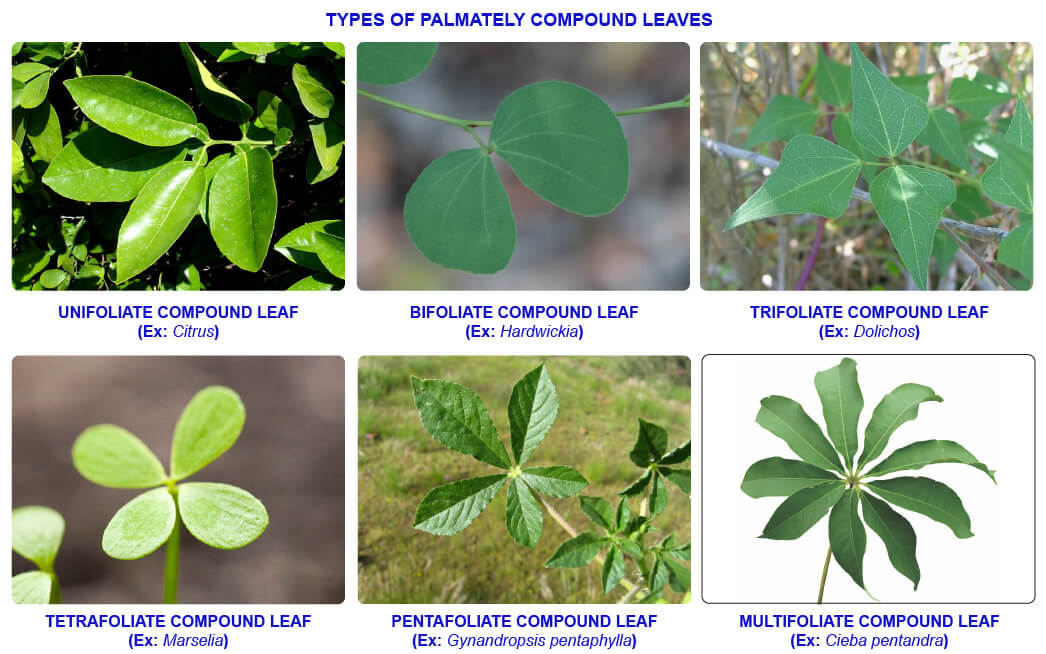
1. Unifoliate compound leaf: Only one leaflet at the tip of the petiole.
Example: Citrus
2. Bifoliate compound leaf: Two leaflets at the tip of the petiole.
Example: Hardwickia
3. Trifoliate compound leaf: Three leaflets at the tip of the petiole.
Example: Dolichos
4. Tetrafoliate compound leaf: Four leaflets at the tip of the petiole.
Example: Marsilea
5. Pentafoliate compound leaf: Five leaflets at the tip of the petiole.
Example: Gynandropsis pentaphylla
6: Multifoliate compound leaf: More than five leaflets at the tip of the petiole.
Example: Cieba pentandra
Formation of different types of leaves on the same plant is called heterophylly. They areof following types:
Environmental Heterophylly: Different kinds of leaves are produced in response to environment where the plant exists
Example: Limnophila, Ranunculus,Sagittaria (Rooted emergent types hydrophytes). *Limnophila is a hydrophyte. Aerial leaves are normal leaves submerged leaves are root like.
Developmental heterophylly: Different kinds of leaves are produced at different stages of development of the plant.
Example: Dolichos seedling shows simple leaves and the developed plant consists of trifoliate compound leave. Similarly in Acacia melanoxylon young leaves are bipinnate compound leaves. Old leaves havo phyllodes only.
Habitual heterophylly - Different types of leaves are present at various nodes. They show different shapes or sizes.
Example: Artocarpus heterophylla, Cycas, Selaginella. *Selaginella there are two types of leaves macrophylls, microphylls.
The mode of arrangement of leaves on the stem and branches is called phyllotaxy. Depepending upon the number of leaves developed at each node the phyllotaxy is of two types namely Radical phyllotaxy and Cauline phyllotaxy.
Radical phyllotaxy: In some plants stem is very much reduced. The leaves arise from this reduced stem but they give false appearance that they have originated from the base of the root. Such leaves are called radical leaves. Eg: Daucus carota, Raphaus sativus, Beta vulgaris.
Cauline phyllotaxy: Leaves are formed from the aerial stem or its branches. It is of three kinds namely alternate, opposite and whorled. Let us study each of them in detail.
Alternate phyllotaxy
Example: Hibiscus, Ficus.
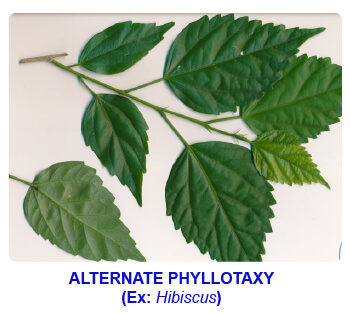
Opposite phyllotaxy
Opposite superposed: In this type, the opposite leaves of all the nodes lie one above other. Example: Quisqualis.
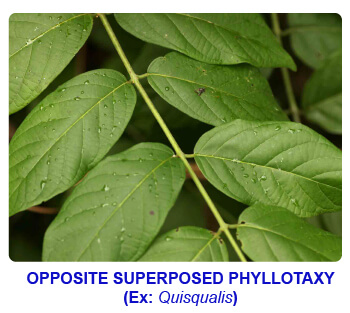
Opposite decussate: In this type, a pair of leaves at one node lie at right angle to the next pair of leaves at the next (successive) node. Example: Calotropis.
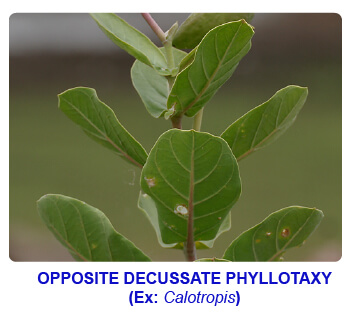
Whorled phyllotaxy
Example: Nerium odorum.
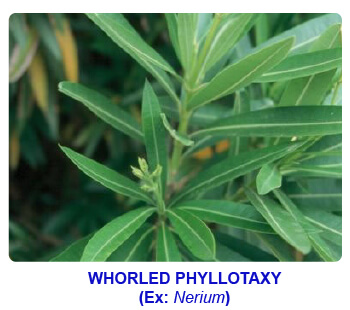
Leaves in Malvaceae: Leaves are cauline, alternate, stipulate, petiolateand dorsiventral, mostly simple (Hibiscus) or palmately lobed or multifoliate, reticulate venation.
Leaves in Fabaceae: Leaves are cauline, alternate, stipulate, petiolate and dorsi-ventral. The leaf base is pulvinus. They are simple, pinnately compound or trifoliate the entire leaf except stipules in Lathyrus and terminal leaflets in Pisum are modified into tendrils. The leaflets in Ulex are modified into spines. Venation is reticulate.
Leaves in Asteraceae: Leaves are usually alternate, simple or compound, and exstipulate. Basal rosettes are common. The small reduced flowers (florets) are arranged in a composite head that is diagnostic for the family and acts as a single functional blossom. The head is subtended by imbricated bracts or phyliaries, collectively called the involucre. Composite heads may be solitary or arranged in corymbs, cymes, panicles or racemes on the plant.
Leaves in Solanaceae: Leaves are exstipulate, petiolate and show alternate phyllotaxy in the vegetative regions, but in the region of inflorescence, they, appear to be opposite or whorled due to the fusion of petiole with the internode. They are usually simple or pinnately lobed. Venation is reticulate.
Hope you have liked this post.
Please share it with your friends through below links.
All the very best from Team Studyandscore
“Study well, Score more…”
- Share with your friends! -
Login to post your comment here...
- or with social Account -